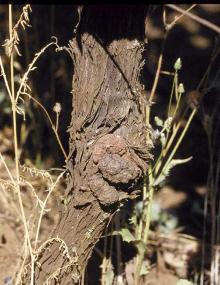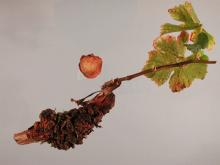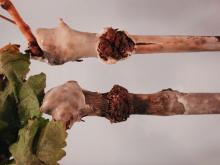See:
Grape (Vitis spp.) Relative Disease Susceptibility and Sensitivity to Sulfur
Cause Allorhizobium vitis (formerly Agrobacterium vitis), a bacterium that attacks only grape and chrysanthemum. Crown gall is most commonly found in regions with cold winters like southern Oregon and areas east of the Cascade Range. The bacterium survives for years in old galls, infected vines, and infected plant debris in the soil. It can enter the plant through wounds, such as grafting wounds, mechanical or cold damage, or pruning cuts. More often than not, the bacterium has already infected the vascular tissues of symptomless grapevines, especially in nursery grown vines for planting in a new vineyard. The bacteria are systemic within the vine and may also have an epiphytic phase on green shoots including shoot tips and meristems. Despite this the bacteria are not found uniformly on or throughout the vine. Roots may provide a nitch for survival in the soil.
This bacteria is a genetic engineer that modifies the grapevine to make it a home and produce a food source. Winter damage that causes minor wounds can trigger the infection process if enough of the bacteria are present. After the bacterium enters a wound, a small piece of its DNA is transferred into the plant's DNA. The foreign DNA transforms normal plant cells in the wounded area into tumor cells. Once transformed, tumor cells proliferate automatically and produce unique substances that the bacteria can use readily as a food source. The result is a gall, a disorganized mass of hyperplastic and hypertrophic tissue. Crown gall is a greater problem on grafted vines than own-rooted vines as the graft union can result in active gall growth even without winter freezes or mechanical damage. Necrosis in the graft union can inhibit graft take. Grape production can drop by 40% on affected vines. Crown gall is also a greater problem on younger vines with a smaller circumference.
Symptoms Fleshy, hard galls are typically found midsummer on the trunk, located at the root crown and on the first 2 ft of the vine above the soil line. Large galls may develop rapidly and completely girdle young vines in one season. Galls may also be numerous at or near graft unions. The galls turn brown by late summer then become dry and corky. After 1 or 2 years, dead galls may flake off the vine. Galled vines generally produce poor shoot growth, and vine portions above the galls may wilt, become chlorotic, and die due to the gall blockage. Infection of young vines may result in stunting and reduced productivity especially in the first two years after planting. Few clusters develop on these shoots and if fruit does form, it often shrivels or will not ripen. Galls are rarely seen on roots but the bacterium may cause areas of dark necrotic lesions on the roots.
Cultural control Cultural management tactics to reduce or eliminate crown gall include planting crown gall-free vines, preventing vine injury, and removing diseased tissue or vines. Regular monitoring then replacement or renewal helps minimize the impact of this disease.
- Growers can purchase crown gall-tested vines from several nurseries. The Clean Plant Center Northwest-Grapes Program in Washington produces vines tested for the crown gall bacteria and other plant pathogens and makes those certified vines available to nurseries to propagate. See: https://www.cpcnorthwest.com/s/grapevines
- Soak dormant cuttings 30 min in hot water at 129°F (50°F to 54°C, more bud death as temp increases) to help eliminate most of the bacteria. Primary buds are killed, but secondary buds should grow well. Some cultivars may be more sensitive than others. Disinfect grafting equipment often.
- Resistant rootstocks are available but grafting will not allow for retraining of vines after severe winter cold damage. Rootstock 3309 is more resistant to gall formation.
- Choose a vineyard location where rapid temperature changes in the fall and spring are not common.
- Use wind machines to raise surface air temperature during winter temperature inversions.
- Avoid any injury near the base of the vine.
- Remove diseased vines including as much old root material as possible from the vineyard.
- Sterilize pruning tools between vines with 10% Clorox (bleach, which also will oxidize your pruning equipment) or shellac thinner (70% ethyl alcohol). Use the two pruners method: have one soaking in the solution of choice while using the other; then switch pruners, leaving the one you just used to soak, and the one that had been soaking to continue pruning. If used as a soak, change solutions every 2 to 3 hours.
- If the gall is high enough on the trunk, a sucker replacement may be brought up from well below the galled areas in nongrafted plants.
- Use a multiple trunk training system, which may allow for trunk replacement without losing an entire vine.
- Do not graft over to a new cultivar on vines that are exhibiting crown gall.
- Prevent late season vigorous growth through water and/or fertility management.
Chemical control The efficacy of chemicals such as copper-based compounds, other chemicals and antibiotics is not satisfactory and thus not recommended.
- Gallex (ready to use) painted on very young galls to reduce further development. Galls may return the next year or if treated late, may continue to develop. Tissue surrounding the gall may be injured especially on younger plants. Prepare the surface by removing soil from around the galled area, and allow the area to dry before applying. Not generally recommended for use because it is often too labor- and time-intensive to apply. Not registered in Idaho. 24-hr reentry.
Biological control Agrobacterium radiobacter K84 (Galltrol) is ineffective since it does not prevent infections. O Nonpathogenic Agrobacterium vitis strain ARK-1, A. vitis strain F2/5 and others have been shown to be effective but are not commercially available. Use of nontumorgentic A. vitis strain F2/5 with a knocked out gene has been shown to prevent root necrosis by blocking the infection process. These various strains could be used to prevent infection during grafting.
References Burr, T.S., Bazzi, C., Sule, S., and Otten, L. 1998. Crown gall of grape: Biology of Agrobacterium vitis and the development of disease control strategies. Plant Disease 82:1288-1297.
Voegel, T. M., McGonigal, P., Nelson, L. M. and Úrbez-Torres, J. R. 2023. Health Status of Ready-to-Plant Grapevine Nursery Material in Canada Regarding Crown Gall and Description of the First Allorhizobium vitis Strain OP-G1 Isolated from British Columbia. Plant Disease, 107:3666-3673.




